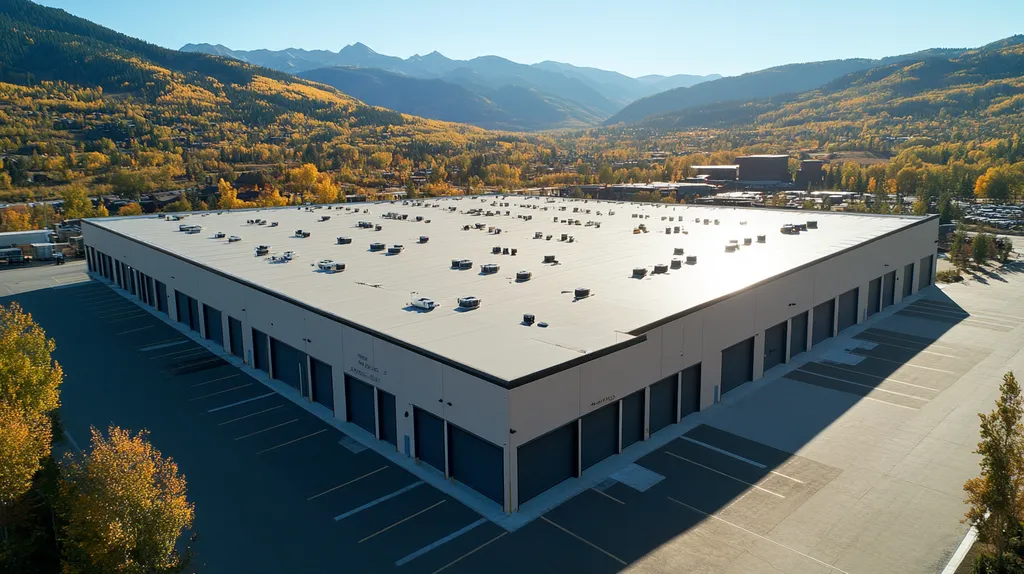Each year, over 11 million tons of roofing waste fills American landfills unnecessarily, with recyclable materials making up nearly 80% of this debris.
As landfill costs continue rising and environmental regulations tighten, the roofing industry faces mounting pressure to adopt sustainable practices.
Yet misconceptions about recycling industrial roofing materials persist, leading many property owners to overlook significant cost-saving opportunities and environmental benefits.
This article examines common myths surrounding roof recycling while providing evidence-based solutions that benefit both business operations and environmental stewardship.
SECTION 1: COMMON MISCONCEPTIONS
Recycling materials from industrial roofs is often passed over, even though the advantages are substantial. Each year, billions of roofing materials find their way to landfills, creating a pressing need for actionable change. Many facility managers and property owners mistakenly perceive recycling as either impractical or cumbersome. By recognizing and addressing these misconceptions, stakeholders can unlock the potential for sustainable roofing practices that save money and significantly lessen environmental impact.
Myth: Recycling is Too Costly
One prevalent belief is that recycling roofing materials incurs higher costs than simply tossing them away. This notion is misleading. In reality, recycling can effectively lower disposal fees and even generate income through the sale of reclaimed materials.
For example, roofing materials like TPO and PVC membranes can command competitive prices when recycled. These earnings can offset any initial recycling costs and bolster the financial health of a facility.
Additionally, various local government agencies and environmental organizations offer incentives for recycling building materials. Such subsidies can alleviate the financial strain on property owners.
In the long run, overlooking recycling as a potential cost-saving strategy can lead to escalating expenses, particularly as landfill fees continue to rise.
Misconception: Limited Recyclable Materials
Another common misunderstanding is that only a handful of roofing types are recyclable. In fact, a diverse range of materials—including metals, membranes, and insulation—can undergo processing for reuse.
For instance, metal roofing elements like aluminum and steel are highly recyclable and can be repurposed entirely without compromising quality.
Moreover, advancements in recycling technology have broadened the spectrum of roofing materials that can be efficiently processed. This progress means that facility managers now have the opportunity to recycle a greater variety of components than ever before.
Being aware of this extensive range of recyclable materials encourages property owners to adopt comprehensive recycling programs. This, in turn, advances a more sustainable roofing industry.
Belief: Recycling is Too Complex
Many property owners and facility managers believe that recycling roofing materials involves a convoluted process. This perspective often stems from outdated information or unfamiliarity with contemporary recycling practices.
In reality, many roofing contractors integrate recycling into their services. They manage the logistics of sorting materials and transporting them to appropriate facilities, simplifying the process.
With clearly defined recycling programs, every step—from collection to transport—is streamlined, making it convenient for organizations to participate. This ease removes much of the perceived burden associated with recycling.
Moreover, implementing recycling programs can enhance a company’s sustainability profile, which is increasingly valued by clients and stakeholders. This alignment promotes environmentally responsible practices while potentially boosting brand reputation.
SECTION 2: PRACTICAL IMPLICATIONS
The choice to recycle materials from industrial roofs is a crucial one in our current environmental and economic context. In the U.S. alone, over 50 million tons of roofing waste are produced each year. This staggering amount highlights the urgent need for effective waste management solutions and underscores the considerable benefits of recycling. Understanding these implications can empower property owners and facility managers to make informed, responsible decisions.
Impact on Waste Management
Recycling materials from industrial roofs plays a pivotal role in shaping how construction waste is managed. By reducing the dependence on landfills, companies can save valuable space and lower waste handling costs. For instance, reprocessed metals and rubber not only lessen the need for new resources but also minimize environmental strain.
Engaging in roofing material recycling promotes a circular economy, which in turn alleviates the environmental burdens associated with material production and disposal. By diverting waste from landfills, organizations can enhance their reputation as stewards of sustainability within their communities.
Efficient waste management also minimizes contamination risks related to roofing materials, leading to a cleaner ecosystem and preventing toxic leachates from entering local waterways. Ultimately, recycling aligns with increasing regulations aimed at diminishing landfill waste. This proactive approach not only lowers operational costs but also positively contributes to community health and safety.
Effects on Environmental Sustainability
Recyclable roofing materials are crucial to advancing environmental sustainability. By reusing resources, the demand for raw materials diminishes, which concurrently reduces energy consumption and greenhouse gas emissions. For instance, recycling asphalt shingles can save enough energy to power hundreds of homes for an entire year.
Additionally, sustainable roofing practices foster biodiversity by mitigating habitat destruction. When materials are repurposed instead of thrown away, there is less environmental harm from resource extraction, providing a holistic solution that addresses both ecological and commercial needs.
Property owners who commit to recycling can elevate their standing as environmentally responsible entities. This resonates with a growing base of eco-conscious consumers, enhancing brand loyalty and attracting potential tenants or clients.
In conclusion, the environmental sustainability linked to recycling roofing materials has far-reaching implications for both our planet and business success. The benefits clearly outweigh any short-term costs, making recycling an important aspect of any commercial roofing endeavor.
Influence on Green Building Certifications
Recycling materials from industrial roofs can greatly enhance a project’s eligibility for green building certifications. Programs like LEED (Leadership in Energy and Environmental Design) reward projects that commit to sustainable construction and renovation practices. Incorporating recycling initiatives helps accumulate credits, thereby improving a building’s overall environmental performance.
By establishing a recycling program for roofing projects, property owners can showcase their dedication to sustainable practices. This not only elevates certification scores but can also unlock financial benefits, such as tax rebates and reduced operating expenses.
Moreover, as clients and stakeholders increasingly prioritize sustainability in their business decisions, achieving green certifications positions companies as leaders in environmentally responsible practices. This strategic focus opens doors to new opportunities and projects.
Ultimately, integrating recycling into roofing strategies enhances a property’s value and marketability. As demand for green building initiatives grows, the ability to boast such credentials becomes increasingly crucial for standing out in a competitive market.
SECTION 3: COST OF MISINFORMATION
The financial and environmental stakes of misunderstanding recycling in industrial roofing are alarmingly high. Many property owners remain unaware of the hidden costs associated with landfilling roofing materials. For reference, landfilling can exceed $300 per ton, whereas recycling not only saves money but can also generate income through resale opportunities. By continuing with outdated practices, property owners miss out on significant savings and sustainable benefits.
Financial Consequences of Landfilling
Choosing to landfill roofing materials results in unnecessary financial strain. Property owners face increasing disposal fees as regulations tighten and landfills reach capacity.
Beyond the tipping fees, there are further expenses associated with compliance and the possibility of fines for improper waste management. Over time, these costs can severely impact the financial health of a business.
Additionally, opting for landfill disposal means missing out on valuable tax incentives designed to promote recycling. These initiatives can significantly alleviate costs, transforming a potential liability into a source of revenue for property owners.
In contrast, recycling not only reduces overall operating costs but also opens avenues for increased cash flow, benefiting the bottom line in the long run.
Missed Opportunities for Cost Savings
By neglecting to recycle roofing materials, property owners forfeit substantial savings opportunities. Many roofing materials, including TPO and PVC, are not just waste; they are valuable commodities that can be reprocessed for various applications.
Recycling these materials can help lower disposal costs while also creating new revenue streams through sales agreements with recycling centers. This wealth of opportunity starkly contrasts with the ongoing expenses associated with landfill disposal.
Moreover, the reduction in material costs derived from recycling efforts can offset a significant portion of the overall expenses involved in roofing projects. Many companies find that investing in recycling initiatives leads to long-term savings.
Ignoring these potential savings can directly affect project budgets. Property owners who fail to consider recycling leave considerable value untapped.
Long-Term Economic Impacts
The long-term economic consequences of clinging to misinformation about recycling can be grave. As landfill costs continue to climb and regulatory pressures mount, companies that neglect recycling will likely struggle to compete.
In today’s market, consumers increasingly prioritize sustainability. Businesses that overlook recycling may fall behind competitors who embrace eco-friendly practices, often enjoying better customer loyalty and improved brand positioning.
Furthermore, with raw material costs surging, the necessity for recycled materials will become more pronounced. Entities that don’t adapt may face operational disruptions as the availability of new materials fluctuates.
Prioritizing recycling is more than a cost-saving measure; it’s an investment in a resilient financial future, ensuring that businesses remain competitive in an evolving market landscape.
SECTION 4: REALITY CHECK
As the challenge of waste management intensifies, recycling industrial roofing materials stands out as a vital opportunity for progress. The National Roofing Contractors Association (NRCA) reports that less than 10% of roofing materials are currently recycled. This statistic reveals a huge amount of waste going to landfills, putting additional strain on our environment. To unlock the potential of recycling, it’s essential to explore its technical feasibility, recognize the types of recyclable materials, and study successful industry examples.
Technical Feasibility of Roof Recycling
The technical feasibility of recycling roofing materials is often underestimated, yet many systems are designed to efficiently process materials like TPO, EPDM, and PVC. These materials can be shredded and transformed into pellets for new roofing applications or other construction products.
Recent advancements in recycling technologies have streamlined the separation and conversion of various roofing materials. These improvements can substantially lower recycling costs, making it a more attractive option for property owners. Organizations that prioritize effective recycling logistics stand to gain both financially and environmentally.
Proper preparation is crucial for successful recycling. Project design should consider how materials can be recycled, and early consultations with specialized contractors can uncover the best strategies. Embracing the feasibility of recycling promotes a sustainable future, turning used materials into valuable resources while conserving our natural environment.
Types of Recyclable Roofing Materials
A wide range of roofing materials are recyclable, each offering unique properties and applications. Metal roofs, such as those made from copper, aluminum, and steel, are particularly valuable. They can often be sold to scrap dealers, providing financial incentives for recycling.
Asphalt shingles are another major component of roofing waste, with many facilities now able to recycle them into liquid asphalt, fiberglass, or cellulose fibers, and mineral aggregate. These recycled materials are primarily used in road construction, thereby reducing landfill impact while enhancing local infrastructure (source: Happy Eco News).
Single-ply roofing systems like TPO and PVC also hold significant recycling potential. Manufacturers have developed effective methods to reclaim these materials, facilitating smarter decision-making regarding their use. By being aware of what materials can be recycled, property managers can guide their teams toward more sustainable installation and replacement choices.
Industry Success Stories in Recycling
Several industry leaders have successfully implemented recycling programs that serve as powerful examples. The Coca-Cola plant in Atlanta, for instance, has achieved an impressive 95% recycling rate for its roofing materials. This commitment demonstrates that recycling can lead to significant environmental benefits.
In California, state policies promote recycling roofing materials, encouraging contractors to adopt better practices related to material reuse and waste diversion. These initiatives foster a culture of sustainability across the region.
Such success stories not only illustrate the potential for widespread adoption of recycling in the roofing industry but also highlight effective practices that can be tailored to individual projects. By encouraging and celebrating these achievements, the industry can forge stronger partnerships with local recycling centers and other stakeholders.
Ultimately, learning from these examples can inspire others to prioritize sustainable methods, paving the way for a more responsible approach to managing roofing waste in the industry.
SECTION 5: EVIDENCE-BASED ALTERNATIVES
As the demand for sustainable practices in commercial roofing grows, understanding recycling options becomes critical. Many property owners remain unaware that both closed-loop and open-loop recycling methods exist, each offering unique advantages. Evidence shows that recycling materials from roofs, particularly metals and PVC, can significantly reduce waste while cutting costs. This section will explore these recycling methods and present compelling case studies that highlight their success.
Closed-Loop vs. Open-Loop Recycling
Closed-loop recycling refers to processes that allow materials to be recycled back into the same product. This method is pivotal for industries like roofing, as it minimizes waste while preserving material quality. For instance, metals such as aluminum and steel can be recycled indefinitely without losing their essential properties.
Conversely, open-loop recycling involves repurposing materials into different product types. While this approach is helpful, it may not maximize resource efficiency the way closed-loop systems do. Understanding the distinctions between these methods empowers property owners to select the most effective recycling options for their projects.
Both methods hold unique benefits, and the choice of which to use typically hinges on the materials involved in the roofing system. By prioritizing closed-loop initiatives, property owners can reduce raw material needs and energy expenses, thus bolstering sustainability.
For example, metals in roofs are often recycled back into new roofing materials, ensuring that their value is retained. This choice aligns well with sustainability goals by providing dependable roofing solutions.
Benefits of Recycling Metal and PVC Roofs
Recycling metal roofs offers substantial benefits, including a reduced environmental footprint and cost savings. Metals like steel and aluminum are highly recyclable and can be processed repeatedly, conserving natural resources while minimizing landfill waste.
PVC roofs, commonly found in industrial applications, also provide excellent recycling opportunities. The recycling of PVC can divert significant amounts of waste from landfills, benefiting the environment while potentially generating revenue from the sale of reclaimed materials.
Furthermore, recycled metals often carry a higher market value, which contributes to overall savings for facility managers. The return on investment associated with recycling is considerable, making it an attractive endeavor for property owners.
Beyond financial incentives, recycling programs enhance a company’s reputation. As environmental stewardship becomes more important, businesses that prioritize recycling showcase their commitment to sustainability.
Case Studies of Successful Recycling Projects
Several companies have successfully implemented recycling strategies that serve as exemplary models for the industry. One notable case involves a roofing contractor who recycled over 80% of materials from an industrial roof removal project. By focusing on metal components, they achieved substantial waste reduction and even earned additional funds from scrap sales.
In another instance, a commercial property management firm replaced a PVC roof while diverting nearly 75% of the materials from landfills. By collaborating with a recycling facility, they streamlined the process and significantly lowered disposal costs.
These cases demonstrate that effective recycling programs not only contribute to environmental objectives but also enhance operational efficiency. Facility managers can gain valuable insights from these initiatives.
Success stories like these highlight the tangible benefits of recycling in roofing. As more businesses embrace these practices, the industry moves toward a more sustainable future.
SECTION 6: TEST AND VERIFY
In the ongoing quest for sustainable roofing practices, confirming the recyclability of materials from industrial roofs is essential. With the roofing industry contributing significantly to waste, proper material removal can play a vital role in minimizing landfill contributions. The Environmental Protection Agency reports that construction and demolition debris accounts for nearly 27% of the U.S. waste stream. By implementing effective testing and verification methods, property owners can bolster recycling efforts and actively participate in environmental stewardship.
Steps for Proper Roof Material Removal
Maximizing recycling potential begins with the correct removal of roofing materials. A thorough assessment of the roof is crucial, which includes identifying the types of membranes, insulation, and flashing materials present.
Engaging trained roofing professionals is vital for ensuring safe and effective removal practices. This not only helps minimize damage to recyclable materials but also reduces the risk of contamination.
After removal, sorting materials on-site can enhance efficiency. This enables smoother processing at recycling facilities, ultimately aiding in the reuse of these materials.
Lastly, property owners should keep detailed records of the materials extracted, including their weight and type. This data can provide insight into the effectiveness of recycling initiatives and help set goals for future projects.
Collaborating with Recycling Facilities
Building strong partnerships with recycling facilities is a cornerstone of the recycling process. Various roofing materials require specific handling to adhere to recycling standards.
Property owners should seek out local recycling centers with experience in roofing materials. Such collaborations can streamline the entire recycling process and facilitate the identification of materials that can be successfully reused.
Open communication with recycling partners can offer valuable insights into best practices and the latest recycling technologies. These insights can prove instrumental during the planning and execution of roofing projects.
Additionally, partnering closely with these facilities helps accurately assess recycled material quantities and qualities, which can inform future planning and operational efficiency.
Measuring and Reporting Recycling Outcomes
Tracking the success of recycling initiatives is critical for continuous improvement. Property owners should diligently document all materials sent for recycling, including their weight and type. This information acts as a benchmark for future projects.
Regularly reporting recycling activities helps identify patterns and opportunities for enhancing material management. It creates a feedback loop that allows for ongoing optimization.
Moreover, sharing positive results with stakeholders fosters transparency and nurtures a sustainable culture within the organization. This collective effort enhances overall commitment to responsible practices.
Ultimately, this systematic approach to measuring and reporting reinforces a broader dedication to improving recycling practices, helping the roofing industry to strengthen its commitment to environmental responsibility.
Looking Ahead
With landfill space diminishing and disposal costs rising above $300 per ton, the roofing industry can no longer afford to ignore recycling opportunities.
The evidence clearly demonstrates that recycling industrial roofing materials is not only technically feasible but financially advantageous, with potential cost savings of 30-50% compared to traditional disposal methods.
By embracing proven recycling strategies and partnering with qualified facilities, property owners can significantly reduce waste management costs while contributing to environmental sustainability.
The time for action is now – as regulations tighten and stakeholder expectations evolve, organizations that fail to implement comprehensive recycling programs risk falling behind competitors and facing increased operational costs.
The future of industrial roofing lies in sustainable practices, with material recycling leading the way toward both environmental and economic benefits.
FREQUENTLY ASKED QUESTIONS
Q. Is recycling materials from industrial roofs too costly?
A. Many people believe that recycling incurs higher costs compared to disposal. In fact, recycling can lower fees and even generate income. Various local programs may also offer incentives, leading to significant long-term savings.
Q. What recyclable materials are found in a commercial roof?
A. A variety of materials, including metals, membranes, and insulation, are recyclable. Advances in technology allow more roofing components to be processed, encouraging comprehensive recycling programs and sustainable practices within the industry.
Q. How does landfilling roofing materials impact costs?
A. Landfilling roofing waste incurs increased fees as regulations tighten. This not only increases disposal costs but also risks fines for improper waste management, negatively affecting a business’s financial health.
Q. What is the current recycling rate for roofing materials?
A. Currently, less than 10% of roofing materials are recycled, showing a significant opportunity for improvement. By addressing recycling gaps, stakeholders can reduce waste and enhance sustainability in the roofing industry.
Q. What are closed-loop and open-loop recycling?
A. Closed-loop recycling allows materials to be reused in the same product form, while open-loop recycling repurposes them into different products. Understanding these concepts empowers property managers to choose effective recycling options.
Q. How can I ensure proper removal of roofing materials?
A. Proper removal involves assessing the roof type, engaging trained professionals, and sorting materials on-site. This approach enhances recycling efficiency and reduces contamination risks, supporting a successful recycling effort.
Q. What examples exist of successful recycling in roofing?
A. Companies like Coca-Cola have achieved high recycling rates for roofing materials. Additionally, various contractors have diverted substantial percentages of waste from landfills, illustrating effective practices that can inspire others in the industry.











